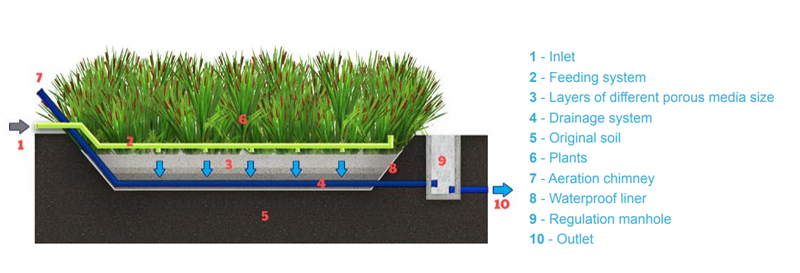- Mitigation title
- Vertical flow wetlands
-

- Description
-
A Vertical Flow (VF) Wetland is a filter media (usually soil or gravel) based marsh, with a series of vegetative basins where water percolates through at soil level. This occurs in two loadings, where air re-enters the pores and aerates the filter allowing aerobic degradation to occur. Water is collected in a loading tank in between each loading.
In VF wetlands a primary treatment is also required to remove any particulate matter, this is to stop the filter media from clogging. The efficiency of VF wetlands is reliant on the filter media that is used and how it is managed.
- Advantages
-
- Reuses water
- Can be fed by gravity (low energy use)
- Of aesthetic value
- Biodiversity enhancement
- Carbon sequestration
- Disadvantages
-
- Requires primary treatment
- Produces Methane
- Large land footprint
- Clogging
- Feeding system requires mechanical component
- Parameters
-
- Phosphorus
- Ammonia
- Nitrogen
- Coliforms
- BOD/COD
- Suspended Solids
- Carbon footprint
-
- Short term energy requirements for earth works
- Time to become effective
-
- Gravel filtration will immediately remove suspended sediment
- Removal of nutrients / organic matter will first need vegetation to become established
- Maintenance
-
- Gravel needs to be renewed as required
- Sludge needs to be removed from primary tank as required
- Suggested cutting back of plants and removal of litter every two to three years
- Performance with time
-
- Performance can be kept at optimum with well a well-established maintenance schedule
- Performance fluctuates with seasonal changes; lower in autumn/winter, highest in spring/summer
- Scaling considerations
-
The size of the wetland is correlated to the load of nutrient removal. Design criteria to meet:
- Monitoring required of the inlet and outlet concentrations and a Population Equivalent must be evidenced
- Hydraulic and mass loading will directly impact sizing, aspect ratio, and depth
- Must take into account climate factors and climate change, such as droughts and dry weather, or water gains from rainfall, etc. As well seasonal dynamics and differences in flows through different seasons.
- Ecology and plant community; what plant species to use
- References
-
Alexandros Stefanakis, C. S. (2014). Vertical Flow Constructed Wetlands. Eco-engineering Systems for Wastewater and Sludge Treatment.
Dotro, G., G Langergraber, Pascal Molle, Nivala, J., Jaume Puigagut Juárez, Stein, O.R., Marcos Von Sperling and Iwa. (2017). Task Group On Mainstreaming The Use Of Treatment Wetlands . Treatment wetlands. London: Iwa Publishing.
ICRA. (n.d.). Vertical Flow Wetlands.
Ricardo for Herefordshire Council. (2021). Interim Phosphate Delivery Plan Stage 2, Mitigation options for phosphate removal in the Wye Catchment.
Silviya Lavrova, B. K. (2013). Nutrients and Organic Matter Removal in a Vertical-Flow Constructed Wetland. Applied Bioremediation.
Wetland Engineering. (n.d.). Treatment Wetlands. Retrieved from https://wetlandengineering.co.uk/treatment-wetlands
